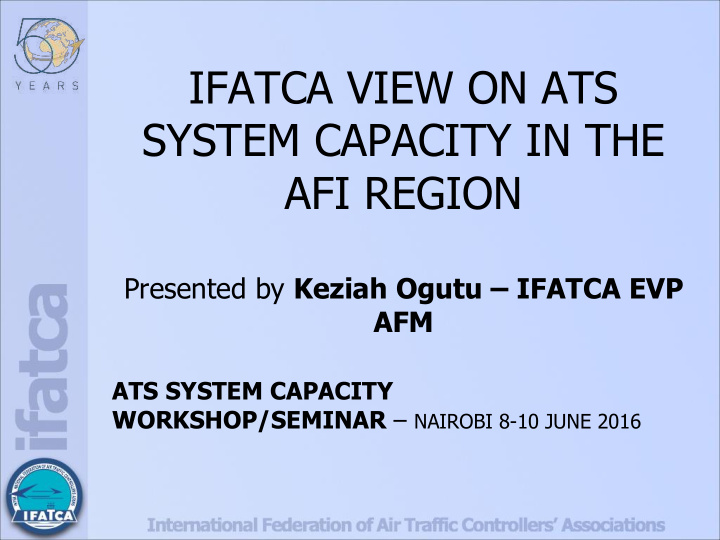



IFATCA VIEW ON ATS SYSTEM CAPACITY IN THE AFI REGION Presented by Keziah Ogutu – IFATCA EVP AFM ATS SYSTEM CAPACITY WORKSHOP/SEMINAR – NAIROBI 8-10 JUNE 2016
AFM Region
FUNDAMENTALS OF ATS ATC is governed by ICAO Annexes – 1 – Personnel Licensing 2 – Rules of the Air 11 – ATS/ PANS ATM 6 – Operations of aircraft / PANS OPS
WHAT IS CAPACITY Capacity is the maximum level of output of goods and/or services that a given system can potentially produce over a set period of time Capacity is the upper limit or ceiling on the load that an operating unit can handle.
SO WHAT IS CAPACITY BASED ON? • Design capacity – Maximum obtainable output • Effective capacity , expected variations – Maximum capacity subject to planned and expected variations such as maintenance, coffee breaks, scheduling conflicts. • Actual output, unexpected variations and demand – Rate of output actually achieved--cannot exceed effective capacity. It is subject to random disruptions: machine break down, absenteeism, material shortages and most importantly the demand .
IFATCA DEFINITION OF SYSTEM CAPACITY IFATCA defines: Sector Capacity: The maximum number of flights that may enter a sector per hour averaged over a sustained period of time, to ensure a safe, orderly and efficient traffic flow. Occupancy Counts: the number of flights occupying a sector simultaneously during a specified period of time. WP 91 - Amman 2011
Efficiency and Utilization Actual output Efficiency = Effective capacity Actual output Utilization = Design capacity 7
AREAS OF CONCERN: MAIN CAUSES OF AIRPROX AND ATS INCIDENTS IN 2015 Staffing levels and workload Deployment of inexperienced staff without adequate supervision Internal coordination between ATCOs of the same unit and strip management ATC coordination between FIRs and Sectors Relevant information between ATC and Flight Crew Airspace organisation and classification (effective separation between VFR and IFR) Human Factors - Human error - ATC ATC procedures System limitation- TCAS Read back/Hear back Communication - A/G and G/G (LANGUAGE AND EQUIPMENT)
AIAG/13 and TAG/8 Recommendations from AIAG/12 Human Factors : Staffing, fatigue, working conditions and equipment Training – refresher/re-currency Investigations and reporting Coordination systems Airspace re-oganisation – rerouting and removing hotspot WPs
AIAG 13 RECOMMENDATION TO ANSPs Review frequencies of eliminate similarity and could cause mix-up • • Increase ATCO staffing according to actual traffic amounts and sectorization as required • Reorganization or reclassification of airspace at airports with mixed VFR/IFR • Improve airspace organization • Improve communication • Improve inter unit coordination and between FIRs and Sectors • Remove distractions in control rooms to reduce human errors and non-adherence to procedures. • A general recommendation to ICAO/IATA to encourage continuous improvement and development of SMS by ANSPs.
TAG 2015 ANALYSIS
IMPROVEMENT AREAS • TRAINING • CPDLC AND ADS-C • INCIDENT REPORTING • COORDINATION MEETINGS • AIRSPACE REORGANISATION • SEMINARS and WORKSHOPS
OUR PROBLEM AS WE SEE IT If you continue to use any system, container, backet etc the same way with increase in load it will burst – system Failure What is our measure for capacity? Is it incidents or accident? Capacity planning – who is doing the analysis, forecasting?
WHAT IS CAPACITY PLANNING Capacity planning is the process of determining the production capacity needed by an organization to meet changing demands for its products. In the context of capacity planning, design capacity is the maximum amount of work that an organization is capable of completing in a given period. Effective capacity is the maximum amount of work that an organization is capable of completing in a given period due to constraints such as quality problems, delays, material handling, manpower, equipment etc.
Determinants of Effective Capacity/Output • Facilities: layout – ATSUs, sectors • Products or services: product mixes/setups • Processes: quality and efficiency • Human considerations: motivation • Operations,: scheduling and synchronization problems – working hours, shift scheduling etc • Supply Chain factor: material shortages – tools, Human resource etc • External forces: regulations e.g procurement processes, MIL restrictions etc 1 5
WHAT NEXT? Embrace existing Technology Harmonize cross border procedures – Wx, routing, control, airspace Redesign airspace to enable emerging technologies Simplify operations - TWR and GND ops can be simplified thro’ datalink and or - SIDS/ STARs – Incorporate Freq. and transfer points. - E.g HKG with 1200mvt daily if they could eliminate all R/T transfers they can reduce by 2400 TXs daily – less ATC/ Crew workload.
CAN WE WE THINK INK OUTSI TSIDE DE THE BOX X IN THIS S REGION? GION? The e man anuf ufactures actures fore recas cast t doub ubling ling flee eets ts on system – predominately 70% into o the aviation of existing infrastructure How ready dy are we for it it?
Recommend
More recommend